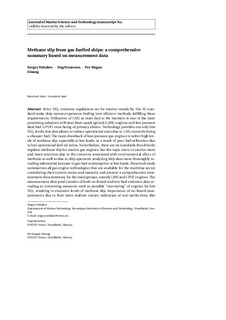| dc.contributor.author | Ushakov, Sergey | |
| dc.contributor.author | Stenersen, Dag | |
| dc.contributor.author | Einang, Per Magne | |
| dc.date.accessioned | 2019-04-10T07:45:42Z | |
| dc.date.available | 2019-04-10T07:45:42Z | |
| dc.date.created | 2019-01-14T09:02:29Z | |
| dc.date.issued | 2018 | |
| dc.identifier.issn | 0948-4280 | |
| dc.identifier.uri | http://hdl.handle.net/11250/2593949 | |
| dc.description.abstract | Strict NO x emission regulations set for marine vessels by Tier III standard make ship owners/operators finding new efficient methods fulfilling these requirements. Utilization of LNG as main fuel at the moment is one of the most promising solutions with lean burn spark ignited (LBSI) engines and low pressure dual fuel (LPDF) ones being of primary choice. Technology provides not only low NO x levels, but also allows to reduce operational costs due to LNG currently being a cheaper fuel. The main drawback of low-pressure gas engines is rather high levels of methane slip, especially at low loads, as a result of poor fuel utilization due to low operational fuel–air ratios. Nevertheless, there are no standards that directly regulate methane slip for marine gas engines, but the topic starts to receive more and more attention due to the concerns associated with environmental effect of methane as well as due to ship operators analyzing ship data more thoroughly revealing substantial increase in gas fuel consumption at low loads. Presented study summarizes all gas engine technologies that are available for the maritime sector considering their current status and maturity and present a comprehensive measurement data summary for the main groups, namely LBSI and LPDF engines. The measurement data pool consists of both on-board and test-bed emission data revealing an interesting moments such as possible “overtuning” of engines for low NO x resulting in excessive levels of methane slip, importance of on-board measurements due to their more realistic nature, utilization of non-perfections, such as fixed emission weight factors for loads, and in Tier III regulations. The article also quantitatively indicates the progress in gas technology development and provides updated specific emission factors for the considered gas engine types. | nb_NO |
| dc.language.iso | eng | nb_NO |
| dc.publisher | Springer Japan | nb_NO |
| dc.subject | Methane slip, Gas engine, LBSI, LPDF, Ship emissions, Tier III Measurements | nb_NO |
| dc.title | Methane slip from gas fuelled ships: a comprehensive summary based on measurement data | nb_NO |
| dc.type | Journal article | nb_NO |
| dc.type | Peer reviewed | nb_NO |
| dc.description.version | acceptedVersion | nb_NO |
| dc.source.journal | Journal of Marine Science and Technology | nb_NO |
| dc.identifier.doi | https://doi.org/10.1007/s00773-018-00622-z | |
| dc.identifier.cristin | 1655802 | |
| dc.description.localcode | Publisher embargo applies until September 29, 2019 | nb_NO |
| cristin.unitcode | 194,64,20,0 | |
| cristin.unitname | Institutt for marin teknikk | |
| cristin.ispublished | true | |
| cristin.fulltext | preprint | |
| cristin.qualitycode | 2 | |
